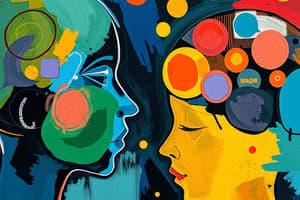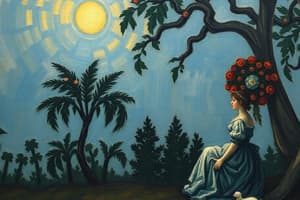Podcast
Questions and Answers
What age range defines a toddler?
What age range defines a toddler?
- 3 to 5 years old
- 1 to 3 years old
- 6 to 10 years old
- 1 ½ to 3 years old (correct)
What is a key focus during early childhood?
What is a key focus during early childhood?
- Developing self-control
- Experiencing rapid physical changes
- Learning fundamental academic skills
- Gaining independence and school readiness (correct)
What cognitive development activity might a toddler engage in?
What cognitive development activity might a toddler engage in?
- Memorizing a poem
- Imagining being an actor (correct)
- Writing a story
- Solving crossword puzzles
What is a defining characteristic of middle and late childhood?
What is a defining characteristic of middle and late childhood?
In which developmental stage does a child typically begin elementary school?
In which developmental stage does a child typically begin elementary school?
What is a primary focus during adolescence?
What is a primary focus during adolescence?
What role does cognitive neuroscience play in development?
What role does cognitive neuroscience play in development?
What emotional change might you observe in a toddler?
What emotional change might you observe in a toddler?
What occurs during the Germinal Period?
What occurs during the Germinal Period?
What does the Trophoblast layer provide for the embryo?
What does the Trophoblast layer provide for the embryo?
What is the primary focus of the Epigenetic View in development?
What is the primary focus of the Epigenetic View in development?
Which of the following statements best captures the Gene × Environment interaction?
Which of the following statements best captures the Gene × Environment interaction?
Which process occurs after the initial creation of the zygote during the Germinal Period?
Which process occurs after the initial creation of the zygote during the Germinal Period?
What is the significance of the Blastocyst in early development?
What is the significance of the Blastocyst in early development?
Which of the following best describes the purpose of cell division during the Germinal Period?
Which of the following best describes the purpose of cell division during the Germinal Period?
During the Germinal Period, the attachment of the zygote occurs to which structure?
During the Germinal Period, the attachment of the zygote occurs to which structure?
Which theory emphasizes the role of behavior, environment, and cognition in development?
Which theory emphasizes the role of behavior, environment, and cognition in development?
What is the primary motivation according to Freud's Psychosexual theories?
What is the primary motivation according to Freud's Psychosexual theories?
In Erikson's Psychosocial theories, what is the primary motivation for development?
In Erikson's Psychosocial theories, what is the primary motivation for development?
Which of the following is NOT one of Piaget's four stages of cognitive development?
Which of the following is NOT one of Piaget's four stages of cognitive development?
What is the concept of 'critical or sensitive periods' most associated with?
What is the concept of 'critical or sensitive periods' most associated with?
In Vygotsky's theory, what process do children primarily use to actively construct their understanding of the world?
In Vygotsky's theory, what process do children primarily use to actively construct their understanding of the world?
Which researcher is associated with the concept of a child's attachment to a caregiver during the first year of life?
Which researcher is associated with the concept of a child's attachment to a caregiver during the first year of life?
What primarily influences developmental change throughout the lifespan according to Erikson?
What primarily influences developmental change throughout the lifespan according to Erikson?
Which of the following best describes behavior in Skinner's operant conditioning?
Which of the following best describes behavior in Skinner's operant conditioning?
Which research design involves studying change over time?
Which research design involves studying change over time?
What does reliability in standardized tests refer to?
What does reliability in standardized tests refer to?
Which of the following theories highlights the influence of biological factors on behavior?
Which of the following theories highlights the influence of biological factors on behavior?
What is the main focus of Bronfenbrenner's Ecological Theory of Development?
What is the main focus of Bronfenbrenner's Ecological Theory of Development?
What structure allows the developing embryo to float in a clear fluid?
What structure allows the developing embryo to float in a clear fluid?
Which embryonic layer is responsible for forming the digestive and respiratory systems?
Which embryonic layer is responsible for forming the digestive and respiratory systems?
During which weeks after conception does the embryonic period occur?
During which weeks after conception does the embryonic period occur?
What is the primary function of the umbilical cord?
What is the primary function of the umbilical cord?
By the end of the embryonic period, which of the following can be detected via ultrasound?
By the end of the embryonic period, which of the following can be detected via ultrasound?
Which of the following is NOT a characteristic of an embryo during the embryonic period?
Which of the following is NOT a characteristic of an embryo during the embryonic period?
At what point is sex distinguishable during prenatal development?
At what point is sex distinguishable during prenatal development?
What is organogenesis?
What is organogenesis?
Which characteristic is observed in the fetus during the second trimester?
Which characteristic is observed in the fetus during the second trimester?
What major function does the placenta serve during fetal development?
What major function does the placenta serve during fetal development?
What is a characteristic of development that indicates it is multidimensional?
What is a characteristic of development that indicates it is multidimensional?
Which of the following statements about normative age-graded influences is correct?
Which of the following statements about normative age-graded influences is correct?
How does plasticity relate to development throughout the lifespan?
How does plasticity relate to development throughout the lifespan?
What does it mean for development to be lifewide?
What does it mean for development to be lifewide?
What is the relationship between biological, sociocultural, and individual factors in development?
What is the relationship between biological, sociocultural, and individual factors in development?
Which statement best reflects the concept of nonnormative life events?
Which statement best reflects the concept of nonnormative life events?
What leads to cumulative development over a lifespan?
What leads to cumulative development over a lifespan?
How does sociocultural context shape health and development?
How does sociocultural context shape health and development?
What does a dynamic and reciprocal process of development imply?
What does a dynamic and reciprocal process of development imply?
Which of the following best describes the concept of maintenance in development during middle and late adulthood?
Which of the following best describes the concept of maintenance in development during middle and late adulthood?
What is one major influence of gender on development?
What is one major influence of gender on development?
Which aspect is critical to understanding the nature of development?
Which aspect is critical to understanding the nature of development?
What role do health professionals attribute to psychological states in relation to well-being?
What role do health professionals attribute to psychological states in relation to well-being?
What is a primary concern within the contemporary study of developmental psychology?
What is a primary concern within the contemporary study of developmental psychology?
Flashcards are hidden until you start studying
Study Notes
Development and Learning Concepts
- Development is a pattern of change starting at conception and continuing throughout life, involving both growth and decline.
- Plasticity refers to the capacity for change in response to experiences throughout the lifespan.
- Development is multidimensional, influenced by biological, social, and cultural factors, and involves simultaneous changes across various dimensions.
- Contextual factors such as historical, economic, social, and cultural elements play crucial roles in shaping development.
- Normative age-graded influences, like puberty and retirement, impact individuals similarly within specific age groups.
- Normative history-graded influences affect generations based on common historical events (e.g., the Great Depression, COVID-19).
Objectives of Developmental Psychology
- Describe changes in individuals at different ages and how they evolve due to aging.
- Explain the causes of developmental changes.
- Predict future developmental outcomes for individuals.
- Intervene and utilize knowledge to enhance individual life quality.
Lifespan Perspective Characteristics
- Development is lifelong, with no single period dominating.
- Development is multidirectional, comprising gains and losses across various dimensions.
- Maintenance and regulation of loss become prominent in middle and late adulthood.
Factors Influencing Development
- Biological processes encompass physical changes, including genetic inheritance, brain development, and overall health.
- Cognitive processes involve thought, intelligence, and language evolution (e.g., vocabulary acquisition, problem-solving).
- Socioemotional processes pertain to relationships, emotions, and personality development.
Contemporary Issues in Development
- Health and well-being are heavily influenced by lifestyle choices and psychological factors.
- Parenting and education are crucial considerations for child development.
- Technology impacts developmental processes and societal behaviors.
Theoretical Frameworks
- Psychoanalytical theories focus on unconscious factors and emotional development, notably Freud's psychosexual theory and Erikson's psychosocial stages.
- Behavioral and social cognitive theories emphasize the role of environment and cognition in behavioral changes (Skinner, Bandura).
- Cognitive theories explore the stages of cognitive development and processes like organization and adaptation (Piaget, Vygotsky).
- Ethological theory connects behavior with biological influences and evolution, recognizing sensitive periods in development.
Research Methods in Developmental Psychology
- Employ various research designs including case studies, correlational studies, and experiments.
- Longitudinal research examines changes over time, while cross-sectional studies compare different age groups.
- Cohort effects can influence findings, necessitating designs like accelerated longitudinal studies to better understand developmental trajectories.
Research Ethics
- Ethical considerations in developmental psychology research encompass confidentiality, informed consent, and minimizing harm to participants.### Germinal Period
- Occurs in the first two weeks after conception.
- Involves creation of the zygote, continued cell division, and attachment to the uterine wall.
- Epigenetic View emphasizes bidirectional interaction between heredity and environment in development.
- Gene x Environment (G x E) Interaction highlights how genetic and environmental factors combine to influence well-being and abilities.
Blastocyst and Trophoblast
- Blastocyst: Inner cell layer that develops into the embryo.
- Trophoblast: Outer cell layer that provides nutrition and support for the embryo.
Embryonic Period
- Occurs from 2 to 8 weeks after conception; rate of cell differentiation significantly increases.
- Mass of cells is termed an embryo, consisting of three layers:
- Endoderm: Forms digestive and respiratory systems.
- Mesoderm: Develops muscular, circulatory, reproductive, and excretory systems.
- Ectoderm: Creates nervous system and sensory organs.
Support Systems and Organ Development
- Amnion: Fluid-filled sac in which the embryo floats.
- Umbilical cord: Contains two arteries and one vein; connects the embryo to the placenta.
- Placenta: Disk-shaped tissue facilitating nutrient and waste exchange between mother and embryo.
- Organogenesis: Organ formation occurs within the first two months of prenatal development.
Key Developments and Milestones
- Detectable fetal heartbeat and limb movement starts at around 12 weeks.
- By 12 weeks, the fetus is approximately 3 inches long, weighs about 1 ounce, and can perform reflexive actions like sucking and swallowing.
- Distinguishable sex and presence of fingerprints occur by this stage.
Second Trimester Developments
- At 16 weeks, the fetus is about 6 inches long and weighs 4 to 7 ounces.
- Heartbeat is strong, skin is thin and transparent, and downy hair (lanugo) covers the body.
- Fingernails and toenails begin to form, and the fetus exhibits coordinated movements, being able to roll over in amniotic fluid.
Studying That Suits You
Use AI to generate personalized quizzes and flashcards to suit your learning preferences.




